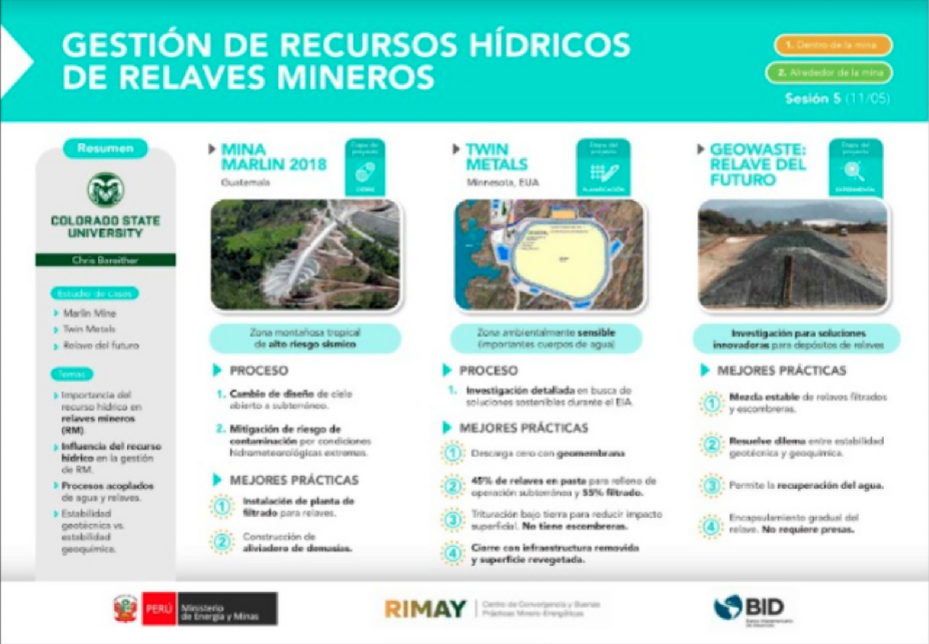PERUMIN HUB MINING INNOVATION IN PERU


CHALLENGESCIRCULAR AND REGENERATIVE MINING
The circular economy has become a key trend to address today’s environmental and economic challenges. Rather than following a linear model of production and consumption, circularity proposes closing the lifecycle of materials and resources—keeping them in use for as long as possible while minimizing waste and pollution.
Implementing circular practices in the mining sector offers significant environmental, social, and economic benefits. This restorative and regenerative approach aims to reduce dependence on energy and raw materials, promoting a more efficient and sustainable use of resources within the economic system. Circular mining represents an opportunity to advance climate change mitigation and adaptation, improve sector competitiveness, lower costs, and strengthen relationships with communities and authorities, aligned with new market demands (CESCO and MinSus, 2022).
How can we reduce water consumption, maximize its reuse, and design mining systems that regenerate water sources?
Peru is one of the countries with the largest amount of freshwater in the world. In the face of a global water scarcity scenario, we have the responsibility to promote management models and technologies that optimize its use, enable reuse, and regenerate water sources.
In the mining sector, water scarcity and lack of coordination in water use have led to low economic productivity and social conflicts. This is both a challenge and an opportunity to find solutions that promote resource exchange, efficient coordination, access to new water sources, and collaborative management (CESCO and MinSus, 2022).
Opportunities and/or Value Elements:
Solutions that include a watershed-based water balance diagnosis and climate change projections.
Solutions that diagnose/measure natural sources (natural water quality surpluses) to validate initial conditions and ease regulatory exceptions.
Solutions that enable collaboration with the National Water Authority and align with national regulations.
Solutions for regenerating water sources with a multisectoral approach (mining, agriculture, energy, and territory) and that promote community involvement.
Solutions focused on reducing consumption and losses (evaporation/leakage).
Real-time monitoring solutions for:
i) water use;
ii) evaporation, leakage, and tailings entrapment losses;
iii) water quantity and quality based on supply watersheds.
Solutions with rainwater harvesting and storage systems integrated into watershed management models.
Solutions to maximize water recirculation and reuse, including other types such as groundwater.
Solutions that avoid perpetual water treatment.
Solutions that ensure sustainable discharge quality during and after operations.
Solutions that leverage undervalued water sources.
Solutions for sulfate and acid water treatment.
Solutions for reusing wastewater in the surrounding area.
Use of non-contact water (e.g., rainwater not involved in mining processes).
Solutions for treating and revalorizing brine and highly saline wastewater.
Nature-based solutions to restore watersheds and water sources.
Solutions that optimize aquifer recharge and infiltration technologies.
Solutions that reduce water footprint in tailings management.
Solutions using biofilters, microorganisms, and nanotechnology to improve reused water quality.
Models that include the productive use of wastewater in nearby industrial or agricultural sectors.

How can we reduce waste and tailings or transform them into valuable inputs for other industries?
As a driving industry, mining plays a fundamental role in the economy, not only through direct contributions but also by influencing the entire value chain. As a major purchaser of goods and services, mining stimulates demand and economic activity across sectors. However, it also has a significant impact in terms of waste generation and environmental footprint. This gives mining a key role in implementing circular economy practices—reducing, reusing, and recycling waste to minimize environmental harm.
Circular economy approaches are relevant not only downstream (e.g., pallets, plastics, tires, electronics) but also upstream (e.g., overburden, effluents, tailings, acid water). It is crucial to apply circular economy principles at every stage—from extraction and processing to final disposal—generating valuable inputs for other industries like construction, manufacturing, or even new advanced materials.
Opportunities and/or Value Elements:
Solutions focused on tailings dam safety, aligned with current standards.
Solutions to extend the lifespan of critical inputs (mill balls, tires, equipment oils, etc.).
Solutions to revalorize tailings with non-metallic minerals (pyrite, carbonates, silicates, etc.).
Solutions to revalorize organic waste for energy generation or agricultural use.
Solutions to revalorize sludge from acid water treatment.
Solutions to recover remaining valuable minerals or elements from tailings.
Solutions to stabilize contaminants and desulfurize tailings for further use.
Solutions to revalorize tailings for construction materials, composites, soil improvement, etc.
Industrial symbiosis models for comprehensive waste reuse.
Solutions for tailings compaction and dewatering (filtered tailings).
Solutions addressing characterization, reduction, and remediation of legacy environmental liabilities with valorization potential. As of February 19, 2025, Peru’s Ministry of Energy and Mines has identified 6,026 mining environmental liabilities (Ministerial Resolution No. 290-2006-MEM/DM).

How can we achieve carbon-neutral mining operations through renewable energy, carbon capture, and ecosystem regeneration?
Mining plays a crucial role in the global sustainable development and climate agenda—not only as a provider of minerals essential to clean technologies, but also as an agent of change capable of adopting innovations to reduce or reverse its carbon footprint and become a carbon-neutral activity.
To achieve this, mining must innovate in strategies to reduce fossil fuel use and carbon emissions across its value chain. This includes Scope 1 (direct emissions), Scope 2 (from energy generation), and Scope 3 (indirect, supply chain-related). Alternatives like solar, wind, biodiesel, and green hydrogen are being explored for an effective energy transition. However, economically viable carbon footprint reduction strategies are still needed.
Opportunities and/or Value Elements:
Solutions that utilize available surfaces for energy generation (solar, wind, etc.).
Solutions that prioritize clean energy sources and reduce carbon footprint.
Cost-efficient solutions tailored to sector conditions such as energy storage, mine site access, environmental factors, etc.
Solutions that integrate renewable energy into mining operations.
Solutions to improve the energy efficiency of mining equipment, focusing on pumping systems.
Long-term solutions including post-closure site use and energy cost reduction.
Solutions incorporating best practices in energy efficiency and carbon reduction (e.g., ISO 50001 standards).
Solutions that integrate carbon footprint monitoring as a key indicator of progress and reputational impact.
Solutions promoting cross-sector or inter-project synergies, considering the full value chain (Scope 3 emissions).
Solutions that offer financial value (carbon credits, green bonds, etc.).
Solutions focused on reducing energy use in mining operations.
Solutions to convert or adapt fixed and mobile equipment for non-fossil fuels, supporting decarbonization of mining transport.
Solutions for energy storage in mining operations.
Solutions for carbon capture using nature-based approaches.

How can we restore the environment during the mine closure process?
Mining is not permanent—it has a defined life cycle. Therefore, companies must establish a plan to ensure that once operations end, conditions are the same or better than before. Mine closure is a complex challenge requiring solutions tailored to the specific context of each operation. Peru’s diverse geography, climate, ecology, and social realities demand differentiated strategies and technologies for environmentally sustainable, economically viable, and socially responsible closure.
Mine closure is a progressive process that begins in the conceptual design phase and ends only when specific closure goals are permanently achieved. There are four closure scenarios:
i) Temporary closure, requiring a detailed care and maintenance plan considering possible future use;
ii) Progressive closure, occurring during mining when a component is no longer useful, involving dismantling, demolition, land reshaping, revegetation, etc.;
iii) Final closure, after resource depletion, requiring complete dismantling, studies, final disposal, physical/geochemical/hydrological stabilization, and revegetation;
iv) Post-closure, where the operator remains responsible for a minimum of five years (MINEM, 2006).
Opportunities and/or Value Elements:
Solutions that promote community involvement (communal enterprises/local actors) in land planning and sustainable post-closure economic activities.
Solutions that reduce visual impacts and improve environmental integration.
Solutions tailored to each closure type: temporary, progressive, final, and post-closure.
Solutions for managing and remediating already-closed mines (as of 2024).
Solutions that create a net positive legacy—environmental, economic, and social.
Solutions that consider carbon emissions reduction and compensation during mine closure.
Innovative solutions for land recovery and reuse with equal or higher economic value, considering risks and limitations.
Solutions to improve soil chemical stability and speed up revegetation, based on soil type and climate.
Real-time environmental monitoring solutions for water, soil, biodiversity, etc., during closure stages.
Nature-based solutions.









